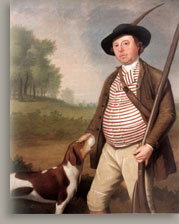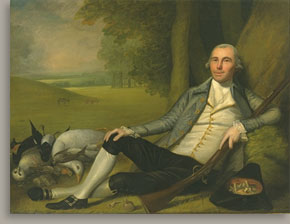 Ralph Earl Ralph EarlPortrait of a Man with a Gun, 1784 Description The subject’s powdered hair is pulled back and apparently gathered in a queue; there is a single tight curl visible above his left ear. He wears a white stock and bow and an orange, spotted waistcoat that is edged with a double row of gold braid and decorated with two rows of small gold-colored buttons. He also has on a red coat with large, silver-colored buttons. His buff-colored breeches are fastened at the knee with cloth-covered buttons of the same color and tucked into knee-high boots that are dark brown at the top and black from the calf to the toe. The man is accompanied by two hunting dogs, whose heads are turned in the direction of his gesture. The dog on the left, its back to the viewer, is placed on a diagonal from the bottom-left corner toward the middle of the image. This animal has a dark gray head and ears and a large gray spot on the back of its neck; its coat is mottled gray and white. The other dog stands in profile behind its master, its neck extended and facing left. This canine has reddish-brown markings on its head and back and a similarly spotted coat. The man and dogs appear in the clearing of a wooded landscape. Gently curving lines of trees recede along the left and right sides; a single tree stands just behind and to the right of the hunter. The sky has large gray clouds whose shapes echo the soft contours of the trees as well as broad passages of pink and blue. Although the figure of the man is rather tightly rendered compared to those in characteristic English paintings of the time, Earl used broad brushstrokes in the landscape, especially in the bush on the left and the soil in the foreground. As in Earl’s indoor portraits, a strong light source from the left defines the modeling and casts a web of shadows beneath the figures. Analysis The suggestion that Earl painted the portrait near Windsor is further supported, although not conclusively, by a letter he wrote at about the time Portrait of a Man with a Gun was produced. Writing to fellow Massachusetts native Dr. Joseph Trumbull in London, Earl reported, "I made your Com[pliments] to Mr West I have finished the large picture and lately finished another and half done a thirde." Since this letter was written on September 23, 1784, and the Worcester Art Museum’s painting is dated 1784, it is possible that this was the "large picture" to which he refers. It is certainly the most ambitious known Earl painting from that year. That he was writing from Windsor and clearly in the company of Benjamin West makes the connection even more interesting, yet still tentative.3 Portrait of a Man with a Gun belongs to a group of similar subjects Earl painted over a short span that reflects his response to contemporary English portraiture. Sporting pictures were popular in England in the seventeenth century and especially the eighteenth century. Thomas Gainsborough, Allan Ramsay, Sir Joshua Reynolds, and John Vanderbank are just a few of the prominent artists whose portraits of aristocrats hunting Earl might have seen in London.4 Elizabeth Kornhauser proposed that "British sporting art appealed to Earl for several reasons, for one, because English country gentlemen and landowners, rather than their urban counterparts, desired it."5
Earl had painted two images of huntsmen, Colonel George Onslow (fig. 1) and Reclining Hunter (fig. 2), before executing the work in the Worcester Art Museum’s collection; both of these are in a considerably smaller format than the present work. The former is a three-quarter-length depiction of a man holding a rifle and touching the neck of his brown-and-white dog, which is shown in profile. In its lines and markings, that hunter’s canine companion is similar to the dog behind its master in Portrait of a Man with a Gun. Onslow’s stout form contrasts with the lean hunter in the Worcester painting, and he appears to stride, unlike the relatively static anonymous sportsman. The landscape is loosely rendered in both paintings, though more open, hilly, and varied in its contours in the Onslow than in the Worcester portrait, with its parklike setting. Reclining Hunter is full length, though horizontal in format. In contrast to the ready acceptance of the conventions of British sporting portraiture in the other two works, this painting is a parody of the theme. This recumbent man’s clothes are too fine for hunting, and he has indiscriminately shot birds not ordinarily hunted as well as a cow and a donkey. His foolishness is underscored by his self-satisfied grin. By contrast, the sober countenance and elegant but proper hunting attire of the man in the Worcester painting suggest a model of gentility.6 The figure in the Worcester painting holds a fine, up-to-date English fowling piece. According to Wallace B. Gusler, master gunsmith at Colonial Williamsburg, the rifle:
Earl’s careful attention to such details is typical of the artist; it would become increasingly apparent in the biographical portraits he later painted in America.
2. Sawitzky and Sawitzky 1960, 30. Letter from Mrs. Henrietta Ryan, Deputy Curator of Print Room, The Royal Library, Windsor Castle, to David R. Brigham, June 5, 1998, object file, Worcester Art Museum. 3. Ralph Earl to Dr. Joseph Trumbull, September 23, 1784, Historic Deerfield, Deerfield, Mass., quoted and reproduced in Sawitzky and Sawitzky 1960, 9, 11–12. Earl’s General Gabriel Christie (Nelson-Atkins Museum of Art, Kansas City, Missouri) is thought to date from about 1783–84 and is of a similarly large scale (81 1/2 x 52 1/2 in.). 4. For example, John Vanderbank, John Dodd, of Swallowfield, Berkshire (1739, Yale Center for British Art, New Haven, Conn.); Allan Ramsay, Thomas, 2nd Baron Mansel of Margram with His Blackwood Half-Brothers and Sisters (1742, Tate Gallery, London); Sir Joshua Reynolds, Philip Gell (1763, private collection); and Thomas Gainsborough, William Poyntz (1762, Earl of Spencer, Althorpe Park). 5. Kornhauser 1991a, 19, 28. 6. Ibid., 26–28, 124–27. Aileen Ribeiro’s costume notes are helpful in evaluating Earl’s intended meaning in Reclining Hunter and Portrait of a Man with a Gun (ibid., 124, 127). 7. Wallace B. Gusler to David R. Brigham, August 27, 1999, object file, Worcester Art Museum.
|


